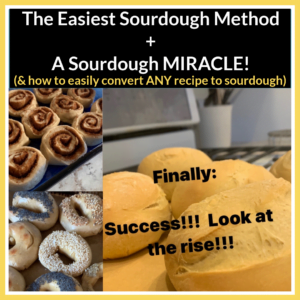
I've finally nailed my sourdough boule!
And okay maybe this is not as beautiful as some, don't ask me how those bread artists make those works of art!! But mine is still kind of pretty in a basic sort of way, and it's quite simple too. 🙂
Before I share the whole sourdough boule recipe and video below, in case you need any of the following info, here's what you'll learn at my other sourdough post:
- WHY is sourdough better –> why it's the healthiest bread on earth, especially if made with at least part organic whole grain einkorn flour! There's more good info about that in this post too, down below the recipe, FYI.
- How my method is so much easier (no weighing out the ingredients!)
- How I made my own sourdough starter from scratch
- What steps to take if someone gives you some of their mature starter
- How to easily adapt any bread recipe to a sourdough bread recipe
- Pizza Pinwheels recipe
- Notes & Resource Links
- A short video showing how easy it is to maintain your fermentation starters (dairy kefir & sourdough)
***First, go here to watch the NEW how-to video***
Getting your starter ready:
This seems like a lot of instructions below, but only because I've experimented a lot and added in all the details in case you want them. Once you make it a few times I promise it'll be simple and no big deal, as you saw in the video, and soon you'll go right through the steps by memory.
- See the other post about starting a starter from scratch or what to do when you get one from a friend, and then also watch the video there about maintaining your starter…
- The night before you want to bake bread, feed your starter. Here's how:
- Pull it from the fridge, take some starter from your jar and put into a clean glass bowl.
- Be sure to reserve some to keep your starter going! I usually give that (the starter still in my jar) a feed in a NEW jar (add about as much flour as you have starter, then add enough filtered water to make a thick pancake batter consistency). Leave out overnight, loosely covered, before putting it back into the fridge the next day. NOTE the new way I store it in the fridge so it keeps longer without having to feed it weekly (if I'm not making bread for a while): I build up the starter to about half of the pint ball jar, then add about an inch of einkorn flour on top of that. Then cover and put into the fridge. This keeps it fine for weeks! When you're ready to bake or want to feed it again, just dump the loose flour off the top into a bowl, scrape off and discard any funky looking hard bits off the top of the starter, then pour the good starter underneath in with the flour in the bowl, add a little water and maybe more flour and stir–now you have refreshed starter!
- Amount of starter to add to your bowl: If you only have a little, pull out even just a Tablespoon; if you have a lot, you can pull out a cup or so, it really doesn't matter because you'll adjust your recipe later. The only thing to keep in mind though, is that if you only have a little, you'll need to start earlier the day before because it'll need more feedings to build it up.
- Just eyeball it and add about as much flour as you have starter in the bowl. It doesn't have to be exact!
- Then add filtered water a little at a time until it's like a thick pancake batter, stir it well.
- Cover loosely (I usually just put a plate on top of the bowl) and let set 2-4 hours until your next feeding, or overnight in a warm-ish spot. After your starter sets for an hour or two you should see active happy bubbles all over and it'll smell so alive! (It'll be a very pleasant sour-ish smell, I love it because it means it's working!) Don't worry if it's not bubbly yet, that just means that it needs more feedings to get going again.
- Notes about feeding:
- To feed it, you don't have to, but I always use whole grain flour at these early steps (if I have it), because it's the whole grains that are the most nutritious and flavorful. But it's also the whole grains that need the long fermenting time, at least 8 hours, to break down the hard-to-digest parts of the grain. When you do this, THAT is what makes sourdough bread the healthiest bread there is! I usually use at least half whole grain flour in my loaves (too much and mine tend to become too dense and brick-like!). And then for the later steps when I'm closer to baking I'll use the unbleached all-purpose white flour. I use either all purpose organic einkorn or another organic unbleached white flour, or some of each. Note that some just make an all white sourdough bread and that's fine too, and still better for you than store-bought for sure, but just not as nutritious as including whole grains.
- I usually have organic whole grain einkorn on hand that I've ground from the whole grain einkorn berries that I get at this link and then I keep that flour in the freezer so it doesn't lose its nutrients as quickly–I don't grind too much at once for that reason. You obviously don't have to grind your grains into flour yourself, most don't do that and it's fine! I've just always heard that flour loses it's nutrients fairly quickly after it's ground, so I do it when I can, but certainly not always. You can also buy whole grain flour einkorn here. Just be sure to keep it in your freezer unless you're going through it pretty quickly. I usually make only one loaf every week or two.
- Remember einkorn is the original wheat and healthiest because it hasn't been hybridized over the years and is easier to digest. I'll also use whole spelt grain/berries sometimes from here, that's also a very ancient grain. See more about this topic below, after the recipe steps.
- Here's the grain mill I have but there's one here that looks good too if you want a smaller pretty one for the countertop.
3. If you started early enough, after 3 hours or so you can feed it again, and then again later, all depending on timing and how much you started with. You'll need to play with this to get a feel for it. It's just nice if I can get more of the whole grain flour fermenting to set overnight so it's even more nutritious. Ideally you'll end up with 3.5 cups, but again, you can easily adjust with your recipe the next day.
4. In the morning I'll feed it again when I get up, sometime between 6:00 am & 8:00 am, then let it set 3 hours or so.
5. By now I've usually got at least 3-4 cups of the whole grain starter. Measure it to see what you have so you can adjust your recipe accordingly: for example, looking at the recipe below, if you only ended up with 2.5 cups of starter instead of the 3.5 cups it calls for, then add another 1 cup of flour and another half cup of liquid to the mix step. The rule of thumb is 1 cup of starter = about 1 cup of flour and half cup of liquid, so you adjust from there.
Making the bread, here's the basic recipe:
Ingredients:
- 3.5 cup active/bubbly starter
- 3.5 cup flour (using whatever flour you prefer or some of each: unbleached organic white bread flour, organic whole grain einkorn flour, organic all-purpose einkorn flour, etc.)
- 2 Tablespoons natural sugar, dissolved into the water (see next), by the way, I'm not using honey anymore after what I read here. (This is optional, but we like it.)
- 1/2 cup warm filtered water (not hot)
- 1 Tablespoon sea salt, add last
- Optional: 1 teaspoon baking soda, also dissolved into the water (NOTE: this is helpful to get a good rise IF you have a starter that is new-ish and not real active yet or if you're using ALL whole grain flour and/or ALL einkorn flour since they sometimes don't rise as well. I got this idea from my friend Wardeh, but she folds it in later at the final shaping step. When I did that I was getting brown distasteful spots in the finished bread where it wasn’t kneaded in all the way–I was afraid to knead/deflate it too much! So I started instead just adding it to my water and sugar step. But now I don’t even use it at all because my starter is so active AND because I’ve been using part organic whole grain/einkorn and part organic unbleached white flour.)
Instructions:
- Mix all of the ingredients together. I use my beloved Bosch to mix/knead for about 3-4 minutes, or you could just stir with this awesome dough whisk and then knead by hand on a lightly floured counter like my Mom used to.
- These amounts are usually just right for me, but flours can be different, so as you do this more, you can tell by how the dough feels if it's good. If it's too wet, just add a bit more flour, if it feels too dry, add a little water, a bit at a time.
- Turn out into a buttered big glass dish and loosely cover. I usually just set a plate on top or some plastic wrap. If your bowl is small-ish and the dough may rise to the top, be sure to butter the bottom of the plate or spray the plastic wrap with avocado spray so it won't stick. Set your alarm for one hour. (Or longer is okay if you're not home, and even 30-40 minutes is okay if you're short on time and need your bread to be done sooner, this recipe is so flexible!)
- When the alarm goes off, pull each side of the dough up and over and push into the middle as I showed in the video, 4 times. Recover loosely and set the alarm for another hour.
- Repeat.
- Now this time, before doing the turns for the third time, prepare a bowl (or a pan or colander) that is close to the size of the pot you'll be baking in, by lining it with parchment paper. Do the dough turns again and then pull out the dough, and either shape it a little in your hands as I did in the video, or just put it seam side down onto a lightly floured counter and turn it a few times on the counter as you shape it into a pretty ball with the sides of your hands. Put the dough seam side down into the parchment paper lined bowl/pan. Use the same covering that you were using on the bowl.
- Now put the covered cast iron pot or dutch oven that you'll be baking in into the oven and heat to 450*. Leave it in there and set the timer for 45-60 minutes. (I use a cast iron pot that is about 8.5″ width and about 7″ high.)
- When the timer goes off, carefully pull the pot out of the oven and uncover. Lift the dough out with the parchment paper corners and carefully place into the hot pot. Don't worry if it doesn't look risen enough, you'll get a lot more rise in the oven if you follow these steps!
- Slice a cross into the top to let steam escape as I showed in the video, using a very sharp knife or this tool that works best. (Again, don't ask me how some people decorate their loaves so beautifully, you should see the mess I made when trying it, lol. A cross is all I can pull off!)
- Mist/spray the loaf and the inside of the pot well with filtered water, this helps build up steam and makes a better rise. I just keep a spray bottle with filtered water under my sink for this.
- Cover and place into the hot oven with a cookie sheet underneath–this keeps the bottom from getting too done and difficult to cut. (Often I forget though and it's still good.) Reduce the oven temp to 425*. Set the timer for 45 minutes.
- When the timer goes off, check the internal bread temp (I have a thermometer like this one) and pull it out when it's at 185*. It'll likely need another 5-15 minutes. I keep the lid on the entire time because I like the top golden brown but not TOO golden and tough because it can be a bit difficult to cut. Others like the lid off to give it an extra crisp crust. I've played with the bake times and having the lid off/on, as you'll see in the video, but this is what I landed on. Feel free to play with this too!
- Using the parchment corners, lift out the loaf and put it on a rack to cool (I got a 2-pack of this baking rack), pulling the parchment out from underneath.
- Let cool before cutting into it, because if you can wait, this makes it much easier and prettier to cut. I usually can NOT wait and slather gobs of beautiful butter all over and shove it into my mouth! It feels so good knowing how good this is for you!
- Notes:
- If I end up adding more whole grains at the mixing step, I'll stretch out the timing on the other steps (depending on how my day is going and/or when I want it to be done) so that it's about 8 hours between the last addition of whole grain flour and baking, just to try to get enough fermenting time in. This doesn't always work out, but I try. The recipe is so easy and forgiving depending all on your time-table!
- You can also let it rise longer than I explained in the recipe if you prefer a more sour sourdough taste or extra fermenting time to make it even more digestible, for those who may still be somewhat sensitive to grains.
- This is a big loaf and I may experiment more with cutting it in half, trying it in bread pans, etc. I'll report back.
- Feel free to comment with any questions so I can fix whatever may not be clear here!
Do you ever wonder why can some people who can't eat bread here in America, eat bread in Italy with no problems at all??
I can't for the life of me find where I got the following quote, so if you know, please tell me so I can give them credit, but this explains it well:
“Estimates show about ⅓ of the US population try to avoid gluten, yet only 7% are actually gluten intolerant. There are many reports of improved gut function, weight loss, less bloating and much more just from simply avoiding gluten. So the question is, why are we having these types of reactions to a food that’s been around forever? And why can many who can’t eat bread here, eat European bread just fine?
Well, a lot has changed. There are 5 main factors that should be looked at:
1. GLYPHOSATE. While gluten intolerance has become more prevalent, glyphosate (the active ingredient in Roundup), has been sprayed on wheat crops here for years. A study compared between 1948-1954 (before the introduction of glyphosate) and 2009, and there was a four-fold increase in celiac disease. (Did you know kids who couldn't eat gluten when you were a kid? I'm in my mid-50's and I didn't know even ONE!) Glyphosate has also been shown to bind to vital nutrients such as iron, manganese, zinc and boron in the soil, preventing plants from taking them up. This leads to a less nutritious plant.
2. ZONULIN. Gluten has been shown to increase zonulin production, a protein that increases intestinal permeability, which can cause leaky gut. When zonulin is released in the intestines, the tight junctions open and allow particles to pass through the intestinal wall, which is what causes symptoms of leaky gut which leads to poor immune health.
3. FORTIFICATION. Almost all wheat products in the US are fortified with synthetic nutrients. Fortified wheat products are some of the worst, most inflammatory foods you can eat ESPECIALLY ones fortified with iron. These nutrients are not bioavailable and can interfere with absorption of other nutrients. This can also lead to excess iron, which is a major cause of gut issues and inflammation.
4. HARD VS. SOFT WHEAT. Most of the wheat in the US is hard wheat, which contains a lot more gluten than soft wheat, which is what’s typically used in Europe. This is one of the reasons why Americans go to Europe and handle wheat products a lot better. Italy, for example, uses almost exclusively soft wheat.
5. DIGESTION. Gluten is a protein, and the digestive enzyme protease is what helps our body break down proteins. Unfortunately, it can’t completely break down gluten. For most people, with a healthy gut, this isn’t a problem. However, if you have gut or autoimmune issues, this can wreak havoc. It is also very high in FODMAPS, which can also cause digestive issues.
Now let’s talk about what we should look for when eating gluten: Is sourdough really better? Sourdough goes through a fermentation process, which starts to break down some of the gluten, making it easier to digest. It also breaks down some of the phytic acid, which can bind to other nutrients making them less bioavailable.
So yes, sourdough is easier on the gut, but it is still very important to look at the quality of the flour used. There are still a lot of sourdough breads out there that use poor quality flour.
Spelt flour, especially sprouted spelt, is a great alternative to modern wheat. It has more fiber, which makes the glucose spike lower than regular flour. It has more vitamins and minerals, has less pesticides, isn’t bleached or fortified, and overall a cleaner product. Organic wheat is not sprayed with glyphosate, which is a major plus. This does not ensure good quality, but at least you have the peace of mind there.“
Einkorn flour is THE original grain of wheat and has even MORE benefits than spelt: read more about Einkorn benefits here and also about hybridization vs. genetic modification/GMOs.
I can't wait to hear how it goes for you when you try this sourdough boule, please let me know!









Leave a Reply